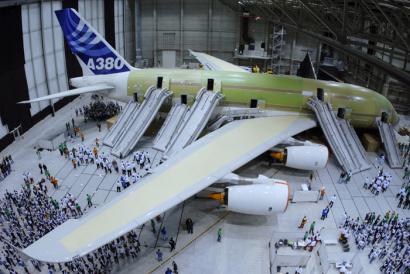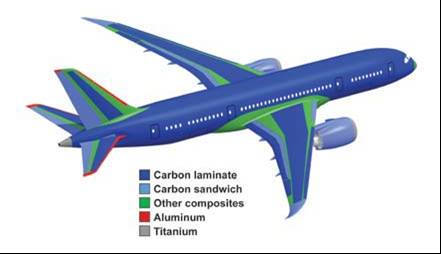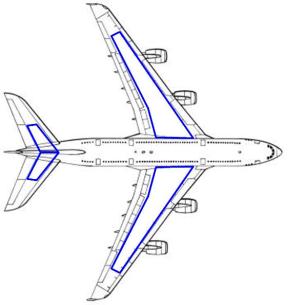New Large Aircraft Fire Fighting Strategies
The Federal Aviation Administration (FAA) Airport Technology R&D Branch’s Operation of New Large Aircraft Research Program is exploring fire fighting strategies and emergency procedures related to NLA, such as the Airbus A380 and Boeing 747-8. During an aircraft emergency, Aircraft Rescue and Fire Fighting (ARFF) services are required to provide an escape path for passengers evacuating the aircraft, extinguish fire, rescue passengers, preserve evidence, minimize damage to property and reduce potential hazards. The unique design of NLA, such as fuel load, fuel tank locations, double-deck cabin, increased passenger capacity, increased footprint of evacuation slides and thermoplastic composite materials, will require research to determine the most effective strategies for ensuring rapid extinguishment, safe evacuation and minimal damage.
NLA pose unique challenges for safe and efficient passenger evacuation. The upper deck of Airbus A380 will be almost as tall as a three story building and require the use of sixteen slides to ensure evacuation of several hundred people. The FAA is advancing research in the areas of heat and fire damage to the slides, positioning ARFF assets around slides for effective fire fighting, assessing hazards of foaming the slides and steep angle decent of passengers from second level slides.
 NLA pose unique challenges for safe and efficient passenger evacuation. The upper deck of Airbus A380 will be almost as tall as a three story building and require the use of sixteen slides to ensure evacuation of several hundred people. The FAA is advancing research in the areas of heat and fire damage to the slides, positioning ARFF assets around slides for effective fire fighting, assessing hazards of foaming the slides and steep angle decent of passengers from second level slides.
NLA pose unique challenges for safe and efficient passenger evacuation. The upper deck of Airbus A380 will be almost as tall as a three story building and require the use of sixteen slides to ensure evacuation of several hundred people. The FAA is advancing research in the areas of heat and fire damage to the slides, positioning ARFF assets around slides for effective fire fighting, assessing hazards of foaming the slides and steep angle decent of passengers from second level slides.
NLA are being designed with higher percentages of composites than ever before. The Airbus A380 will be 25% by weight composites including 23% carbon fiber-reinforced polymer and 3% GLARE fiberglass reinforced aluminum. The Boeing 787 Dreamliner is pushing the envelope with a total composite of 50% by weight, including the integration of an all composite fuselage, wings and tail. Research conducted to date shows that some composite materials sustain significant damage after only 10 seconds of heat exposure. Composite fires tend to be deep seated (similar to a charcoal fire), continue to smolder internally and require copious amounts of water to fully extinguish. The FAA is investigating what types of agents, application methods and quantities are optimal for quickly extinguishing composite fires.
 conducted to date shows that some composite materials sustain significant damage after only 10 seconds of heat exposure. Composite fires tend to be deep seated (similar to a charcoal fire), continue to smolder internally and require copious amounts of water to fully extinguish. The FAA is investigating what types of agents, application methods and quantities are optimal for quickly extinguishing composite fires.
conducted to date shows that some composite materials sustain significant damage after only 10 seconds of heat exposure. Composite fires tend to be deep seated (similar to a charcoal fire), continue to smolder internally and require copious amounts of water to fully extinguish. The FAA is investigating what types of agents, application methods and quantities are optimal for quickly extinguishing composite fires.
NLA are being designed with extensive networks of fuel tanks. In an effort to increase the range of these aircraft, fuel tanks are located in center wing boxes, wings and vertical stabilizers and can carry over 80,000 gallons of fuel in one flight. This increased fuel load and multiple locations may affect ARFF services, especially since current fire fighting agent quantity recommendations are based solely on wing tanks. The added fuel load could contribute to a larger pool fire area and the multiple locations could change the dynamics of effectively attacking three dimensional spray fuel fires. The FAA will focus research on determining additional hazards and fire fighting procedures involving aircraft with unique fuel storage locations.

Mr. Keith Bagot
FAA Technical Center
Operation of NLA Research Program
ANG-E261, Bldg. 296
Atlantic City International Airport, New Jersey, 08405
Contact Project Lead: Keith Bagot, ANG-E261
Last Update:
05/31/12